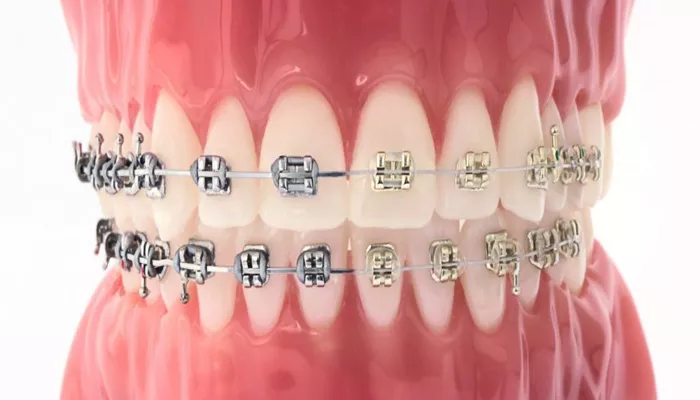Orthodontics is a specialized field of dentistry focused on diagnosing, preventing, and treating dental and facial irregularities. Among the various tools used in orthodontic treatment, dental bands and brackets play crucial roles. While both are essential components of braces, they serve different purposes and have distinct characteristics. This article will explore the differences between dental bands and brackets, providing a comprehensive understanding of each component’s function, materials, application, and benefits.
What Are Dental Bands?
Dental bands are metal rings typically made of stainless steel that wrap around the teeth. They are often used in conjunction with braces to provide a stable foundation for orthodontic treatment.
Design and Composition: Dental bands are designed to fit snugly around the tooth. They are usually thicker than brackets and cover more surface area, which allows them to withstand significant force during tooth movement.
Application: Bands are primarily placed on the back teeth (molars) where they can support additional orthodontic appliances like headgear or springs. In some cases, they may also be used on front teeth if necessary.
Purpose: The main function of dental bands is to provide an anchor point for other orthodontic devices. They help in correcting bite issues by allowing for more significant adjustments to the position of the teeth.
SEE ALSO: Which Factors Are Environmental Causes of Orthodontic Problems
Advantages:
Durability: Due to their robust design, dental bands are less likely to become loose compared to brackets.
Support for Complex Cases: They can manage more complex orthodontic corrections, making them ideal for patients with severe misalignment or those who participate in contact sports.
What Are Brackets?
Brackets are small devices that are attached directly to each tooth using a special dental adhesive. They play a different yet complementary role in the orthodontic process.
Design and Composition: Brackets can be made from various materials, including metal, ceramic, or plastic. They are smaller than dental bands and come in different shapes and sizes depending on the type of braces being used.
Application: Brackets are attached to each individual tooth and serve as guides for moving teeth into their desired positions. They hold the archwire in place, which connects all brackets together.
Purpose: The primary function of brackets is to facilitate tooth movement by applying pressure through the archwire. This pressure gradually shifts the teeth into alignment over time.
Advantages:
Aesthetic Options: Ceramic brackets can be less noticeable than traditional metal ones, making them a popular choice for adults seeking orthodontic treatment.
Precision in Movement: Brackets allow for finer control over tooth movement due to their direct attachment to individual teeth.
Key Differences Between Dental Bands And Brackets
| Feature | Dental Bands | Brackets |
| Material | Stainless steel | Metal, ceramic, or plastic |
| Design | Thick metal ring covering the tooth | Small square or rectangular shape |
| Placement | Typically on molars; may be on other teeth | Attached directly to each tooth |
| Function | Provides anchorage for appliances | Guides tooth movement via archwire |
| Durability | More durable; less likely to loosen | May come loose but can be reattached easily |
| Aesthetic Options | Limited aesthetic choices | Available in clear or tooth-colored options |
When Are Dental Bands Used?
Dental bands are often recommended based on specific patient needs:
Severe Misalignment: For patients with significant bite issues or crowding, dental bands provide a stronger anchoring point for corrective devices.
Children’s Orthodontics: In younger patients whose teeth are still developing, bands can accommodate growth while supporting orthodontic appliances.
Active Lifestyles: For individuals who engage in contact sports, bands offer enhanced stability as they are less prone to damage compared to brackets.
When Are Brackets Used?
Brackets are commonly used in various orthodontic treatments:
Traditional Metal Braces: The most common type involves metal brackets attached to each tooth with wires connecting them.
Ceramic Braces: These use clear or tooth-colored brackets for a more discreet appearance while providing similar functionality as metal brackets.
Lingual Braces: These brackets are placed on the back of teeth, making them invisible from the front.
Combination of Bands And Brackets in Treatment
In many cases, orthodontic treatment involves both dental bands and brackets working together:
Initial Assessment: An orthodontist evaluates the patient’s dental structure and decides whether bands or brackets—or both—are necessary based on individual needs.
Placement Procedure:
First, dental bands may be placed on molars.
Then, brackets are affixed to each tooth using a bonding agent.
Archwires connect all components, allowing for coordinated movement across the dental arch.
Adjustment Periods: Throughout treatment, adjustments will be made by tightening wires or replacing components as necessary. This ensures that teeth continue moving toward their ideal positions.
Maintenance of Bands And Brackets
Proper care is essential for both dental bands and brackets during orthodontic treatment:
Oral Hygiene Practices:
Patients should brush their teeth at least twice daily using fluoride toothpaste.
Flossing around brackets and under bands is crucial to prevent plaque buildup.
Regular Orthodontic Visits:
Regular check-ups allow the orthodontist to monitor progress and make necessary adjustments.
Any loose bands or brackets should be reported immediately to avoid delays in treatment.
Conclusion
Understanding the differences between dental bands and brackets is vital for anyone considering orthodontic treatment.
Each component serves a unique purpose but works together harmoniously within the overall system of braces. Dental bands offer robust support for major corrections while brackets provide precise control over tooth movement.
Choosing between these options depends on individual needs assessed by an orthodontist. By maintaining proper oral hygiene and attending regular appointments, patients can ensure effective treatment outcomes that lead to healthier smiles.
Related topics:

